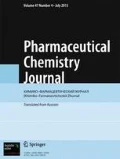The objective of this work was to develop and characterise an amikacin sulfate loaded emulgel to be used as a co-adjuvant treatment for mycetoma caused by principal agents Actinomadura madurae and Nocardia brasiliensis. Development of the amikacin sulfate emulgel was conducted in 3 stages: (1) formulation of the emulsion containing amikacin; (2) selection of the proportion of pluronic F-127 necessary to form a gel; and (3) formation of the emulgel. The emulgel was characterised by the values of pH, relative density, accelerated stability, viscosity, extensibility, adhesiveness, cumulative amount of amikacin, and skin permeation (kp and flux). The proportion of emulsifiers in the emulsion was 10% and 0.77% (w/w) of amikacin, and the emulsion was stable when subjected to the centrifugal test. Agel with 30% pluronic F-127 and an average adhesiveness of 2.7 mJ was used to form the emulgel. The formulated amikacin sulfate emulgel has the following properties: pH 5.5; relative density, 0.907; accelerated stability (centrifugation); extensibility. 923.72 mm2; adhesiveness, 1.27 mJ; cumulative amikacin (within 24 h), 34.13%; F = 105 μg/cm2/h; kp = 0.016 cm/h; and tLag = 14.75 h. The emulgel formulation contains 0.77% of amikacin and demonstrates appropriate technical characteristics to be used as a complement to systemic administration for the treatment of mycetoma.











Similar content being viewed by others
References
E. Torres, E. Vasquez del Mercado, G. Moreno, et al., Dermatol. Rev. Mex., 52(2), 65 – 69 (2008).
B. G. Katzung, Farmacología básica y clínica, (10 Edn.) El Manual Moderno: México (2007), pp. 41 – 45.
L. M. Gómez Peláez, Elaboración y caracterización de sistemas semisólidos bioadhesivos de liberación controlada para el tratamiento de ectoparásitos (B. Microplus) en bovinos, FESC UNAM: México (2009). pp. 35 – 41.
Ajazuddim, A. Alexander, Ajita Khichariya, et al., J. Cont. Release, 171, 122 – 132 (2013).
R. A. Palma, L. A. Hernádez, B. I. Mejía, et al., RMCF, 36(2), 16 – 25 (2005).
M. López Cervantes, J. J. Escobar Chávez, N. Casas Alancaster, et al., Drug. Dev. Ind. Pharm., 35(12), 1511 – 1521 (2009).
J. J. Escobar Chávez, M. López Cervantes, A. Naik, et al., J. Pharm. Pharmaceut. Sci., 9(3), 339 – 358 (2006).
M. López Cervantes, J. J. Escobar Chávez, and L. M. Melgoza Contreras, Desarrollo y validación de un método analítico espectrofotométrico para la cuantificación de amikacina. XXIV Congreso Nacional de Educación Química Farmacéutica Biológica y XX Reunión Nacional de Estudiantes de Farmacia del Colegio Nacional de Químicos Farmacéuticos Biólogos México A. C., México (2015).
M. E. Aulton, Farmacia: La ciencia del diseño de las formas farmacéuticas, Elsevier: Madrid (2004).
J. L. Vila Jato, Tecnología farmacéutica: Formas farmacéuticas, Síntesis: España (2001), pp. 416 – 421.
K. Lathiyare, P. Suresh, and V. Jain, Int. J. Pharm. Pharm. Res., 2(3), 18 – 32 (2015).
S. Yaja man, K. Ketousetuo, A. K. Bandyopadhyay, J. Control. Rel., 114, 15 – 40 (2006).
B. K. Shin, E. J. Baek, S. G. Choi, et al., Drug. Dev. Ind. Pharm., 39(12), 1874 – 1880 (2013).
P. Serrano Castañeda, J. J. Escobar-Chávez, J. Arroyo-Vázquez, et al., Iran. J. Pharm Res., DOI: https://doi.org/10.22037/IJPR.2019.1100914 (2019).
P. Serrano Castañeda, J. J. Escobar Chávez, A. Torres Aguado, et al., Farmacia, 65(6) 908 – 916 (2017).
K. S. Constantino González, Emulgel de sulfato de amikacina como nueva alternativa de administración tópica para el tratamiento del micetoma ocasionado por Actinomadura madurae: Diseño y caracterización, FESC UNAM: México (2016), pp. 67 – 88.
E. Y. Ochoa Félix, Estudio in vivo e in vitro de la sensibilidad de actinomadura madurae frente a diversos antimicrobianos de reciente desarrollo. UANL: México (2004), pp. 31 – 47.
Acknowledgments
This work was supported by UNAM-PAPIIT IG 100220. Dr. Escobar Chávez wants to acknowledge PAPIME PE 201420 and Cátedra PIAPI 2015.
Author information
Authors and Affiliations
Corresponding author
Ethics declarations
Conflict of Interests
The authors declare that they have no conflict of interest.
Rights and permissions
About this article
Cite this article
Constantino-González, K.S., Serrano-Castañeda, P., Guadarrama-Escobar, O.R. et al. Development and Characterization of Amikacin Loaded Emulgel for the Treatment of Mycetoma. Pharm Chem J 54, 1024–1032 (2021). https://doi.org/10.1007/s11094-021-02315-1
Received:
Published:
Issue Date:
DOI: https://doi.org/10.1007/s11094-021-02315-1




